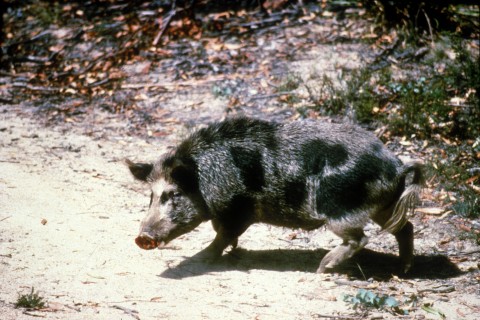Pigs in paradise

Feral pigs (Sus scrofa) are widespread in northern Australia. Pigs are on our farm lands, in the bush, on the beach and in the world heritage areas of the Wet Tropics rainforest. CSIRO scientists who are monitoring and modelling pig populations in Queensland have one message: Protect what you love.
Strategically, the big picture of pig management can be visualised as an invasion curve. The four stages of an invasion are prevention, eradication, containment and asset protection. Once a wild population of pigs is established, only very rarely will the conditions needed for eradication be met1. The resources for pig control, therefore are divided between containment and asset protection.
CSIRO scientist Justin Perry works in partnership with indigenous organisations from the Coen and Aurukun regions on Cape York. He said, in the past, money for pig control has been inconsistent and poorly targeted. Pigs are smart, well-resourced and prolific breeders. If you don't have consistent control the population will increase back to carrying capacity in a very short time2.
Perry said “How many pigs did you kill?” is an easy figure to report but it doesn't tell you anything about the environmental impact of your management. “You might have killed 100000 pigs but the net impact of biodiversity protection may be zero because you haven't made a choice about what you want to protect.”
Historically on Cape York, there has been a regional focus for pig management. But the impact of pigs is non-random. In places where there is complexity in the landscape, like for example, where there is fresh water next to a beach, you get enormous densities of pigs. If you want to have an impact of assets that are valued by the community and important for ecosystem health it is important to target the areas where the biggest impact will be made.
Examples from northern Australian where asset protection is needed include species with a vulnerable stage in their lifecycle. At a turtle nesting area on the western coast of Cape York, 40% of turtle nests were lost during the nesting season, with pig predation responsible for 90% of the overall mortality3.
Individuals of one turtle species, the Olive Ridley, are commonly seen in the water around Cape York. However their nesting areas are not well known except for one 10km stretch of beach south of the Archer River near Aurukun. Perry said, by 2012 researchers from Cape York Sustainable Futures had recorded 100% predation of Olive Ridley nests for several years. “At that point we decided we couldn't keep watching the decline. We had to change the “end game” and make it our goal to protect Olive Ridleys at that nesting site.”
We went through a thorough participatory planning process with the Aurukun community, Perry added, because in our experience if the community are not part of the decision making process the outcomes are poor. “People were not thinking about the future. That is, if every nest that's been measured has been predated, in 14-30 years, there could be no turtles nesting on this beach. That's the reality of 100% predation.” We worked together to build an understanding of the consequences of doing nothing and consulted with traditional owners and pig experts to find a method of culling the pigs that was acceptable to the Aurukun people.
Perry said, “We got permission to change the timing of the control program, which had previously been targeted to get the maximum number of pigs. Instead we did the cull when the benefit for turtle nesting would be highest. Using baited grain, we killed about 360 pigs. For Cape York that is not a huge number, but those pigs were the ones that were doing the damage. We went from 100% predation to 90% nesting success.”
Resource allocation for pig management is the outcome of complex political and cultural influences. Strategic allocation of resources to locally focussed projects with clear ecological or cultural goals can be more widely implemented in northern Australia. Perry said, “We can't protect all biodiversity or all places, but we can be more effective if we decide what it is we value the most.”
1. Hone J. Applied population and community ecology: the case of feral pigs in Australia. John Wiley & Sons, 2012; https://books.google.com/books...zTXHK4bCV4.
2. Bengsen A, Gentle M, Mitchell J et al. Impacts and management of wild pigs (Sus scrofa) in Australia. Mammal Review 2014;44:135147.
3. Whytlaw PA, Edwards W, Congdon BC. Marine turtle nest depredation by feral pigs (Sus scrofa) on the Western Cape York Peninsula, Australia: implications for management. 2013; https://www.publish.csiro.au/?paper=WR12198.





